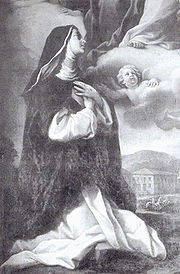This is an old revision of this page, as edited by KolbertBot (talk | contribs) at 11:02, 27 August 2017 (Bot: HTTP→HTTPS). The present address (URL) is a permanent link to this revision, which may differ significantly from the current revision.
Revision as of 11:02, 27 August 2017 by KolbertBot (talk | contribs) (Bot: HTTP→HTTPS)(diff) ← Previous revision | Latest revision (diff) | Newer revision → (diff)
Mother Bertranda, O.P. (née Janina Siestrzewitowska; 1900–1988), and later known as Anna Borkowska, was a Polish cloistered Dominican nun who served as the prioress of her monastery in Kolonia Wileńska, near Wilno, Poland (now Vilnius, Lithuania). She was a graduate of the University of Kraków who had entered the monastery after her studies. During World War II, under her leadership, the nuns of the monastery sheltered 17 young Jewish activists from Nazi persecution. In recognition of this, in 1984 she was awarded the title of Righteous among the Nations by Yad Vashem.
Hiding Jews
Vilnius was taken over by the Germans on 24 June 1941, in Operation Barbarossa, and the killing of the Jews began almost immediately. Mother Betranda first agitated to save Vilnius’ Jewish population following the start of the Ponary massacre in July 1941. She initially sought to gain the support of the Vilnius Catholic leadership, but they rebuffed her efforts out of fear that the Nazi German occupation forces would destroy church property and kill any Christian(s) found to be aiding Jews.
Acting on her own initiative, Mother Betranda then took in 17 members of Hashomer Hatzair, a local Zionist group, and hid them within the grounds of her monastery. The activists included Abba Kovner, the movement's leader, Abraham Suckerwer, Arie Wilner and Edek Boraks. They helped the nuns with working their fields, while Kovner, realizing the goals of Hitler's Final Solution, worked on organizing a political resistance to the occupation and writing his manifesto for the later uprising. When several of her nuns objected, Mother Bertranda reportedly threatened them with expulsion from the monastery and excommunication from the faith. Some of the Hashomer Hatzair members later decided to leave their monastery hideout and to return to the Jewish Ghetto in Vilnius, where they organized an underground resistance movement.
Ghetto uprising
Soon after that, Mother Bertranda left the monastery and went to the Ghetto to volunteer her services. She was dissuaded from this by Kovner, who asked that she organize the procurement of supplies instead. She and the other Dominican nuns then took it upon themselves to help the Jewish resistance by smuggling in arms and ammunition. The other nuns of the community included Sister Bernadeta, O.P. (Julia Michrowska), Sister Cecylia, O.P. (Maria Roszek), Sister Diana, O.P. (Helena Frackiewicz), Sister Imelda, O.P. (Maria Neugebauer), Sister Jordana, O.P. (Maria Ostrejko), Sister Małgorzata, O.P. (Irena Adamek) and Sister Stefania, O.P. (Stanisława Bednarska). In this they became among the first to supply hand grenades and other weapons to the Vilnius ghetto underground. Between August and September 1943, some 12,000 men, women and children were deported to camps in Estonia. The uprising, organized by Fareynikte Partizaner Organizatsye (the United Partisan Organization) on 1 September 1943 was crushed. The final Nazi destruction of whatever remained of the Ghetto followed.
In September 1943, Mother Bertranda was arrested by the Nazi German occupation authorities and sent to a labor camp at Perwejniszki, near Kaunas (Template:Lang-pl). The monastery was closed and the community of nuns was forced to disperse. After the war, Mother Bertranda asked for a dispensation from her vows and left the monastery, where she adopted the name Anna Borkowska. She reportedly remained a faithful Catholic, nonetheless.
Recognition
In 1984, Borkowska, now living alone in a small apartment in Warsaw, was awarded the title of Righteous among the Nations by Yad Vashem. Abba Kovner, one of the young Jews who had been saved by Borkowska, personally presented a medal to her at a ceremony in Poland. She was the only member of her monastic community to be honored, according to the statistics given by Yad Vashem.
See also
Notes
- ^ "Historia pomocy - Borkowska Anna | Polscy Sprawiedliwi" (in Polish). Muzeum Historii Żydów Polskich. Retrieved 12 August 2017.
- ^ Yad Vashem (2012). "Anna Borkowska, Poland". The Righteous among the Nations. Holocaust Martyrs' and Heroes' Remembrance Authority. Retrieved 25 November 2012.
...only in 1984 was contact with her reestablished. By that time she was 84 years old.
- ^ Gross, David C. (1981). The Jewish People's Almanac. Garden City, New York: Doubleday & Company. pp. 465–66. ISBN 0385156529.
{{cite book}}: Italic or bold markup not allowed in:|publisher=(help) - ^ Poray, Anna. "Sister Anna Borkowska". Polish Righteous: Those Who Risked Their Lives. Archived from the original on January 10, 2008. Retrieved 24 November 2012.
{{cite web}}: Unknown parameter|deadurl=ignored (|url-status=suggested) (help) - ^ Paul, Mark (2009). "Wartime Rescue of Jews by the Polish Catholic Clergy: The Testimony of Survivors" (PDF). Polish Educational Foundation in North America. Archived from the original (PDF file, direct download 1.21 MB) on 20 August 2013. Retrieved 25 November 2012.
{{cite web}}: Italic or bold markup not allowed in:|publisher=(help); Unknown parameter|dead-url=ignored (|url-status=suggested) (help) - Porat, Dina (2010). The Fall of a Sparrow. Translated by Elizabeth Yuval. Stanford University Press. p. 51. ISBN 0804762481. Retrieved 25 November 2012.
- Yad Vashem (2012). "Righteous Among the Nations: Poland" (PDF). Names and Numbers per Country & Ethnic Origin, as of 1 January 2012. The Holocaust Martyrs' and Heroes' Remembrance Authority. p. 8. Archived from the original (PDF file, direct download 1.16 MB) on 17 August 2012. Retrieved 25 November 2012.
{{cite web}}: Unknown parameter|deadurl=ignored (|url-status=suggested) (help)
External links
- Anna Borkowska at Yad Vashem website